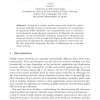Free Online Productivity Tools
i2Speak
i2Symbol
i2OCR
iTex2Img
iWeb2Print
iWeb2Shot
i2Type
iPdf2Split
iPdf2Merge
i2Bopomofo
i2Arabic
i2Style
i2Image
i2PDF
iLatex2Rtf
Sci2ools
DCOSS
2008
Springer
2008
Springer
On the Urban Connectivity of Vehicular Sensor Networks
Abstract. Aiming at a realistic mobile connectivity model for vehicular sensor networks in urban environments, we propose the combination of large-scale traffic simulation and computational tools to characterize fundamental graph-theoretic parameters. To illustrate the proposed approach, we use the DIVERT simulation framework to illuminate the temporal evolution of the average node degree in this class of networks and provide an algorithm for computing the transitive connectivity profile that ultimately determines the flow of information in a vehicular sensor network.
DCOSS 2008 | Distributed And Parallel Computing | Fundamental Graph-theoretic Parameters | Realistic Mobile Connectivity | Vehicular Sensor Network |
| Added | 19 Oct 2010 |
| Updated | 19 Oct 2010 |
| Type | Conference |
| Year | 2008 |
| Where | DCOSS |
| Authors | Hugo Conceição, Michel Ferreira, João Barros |
Comments (0)

